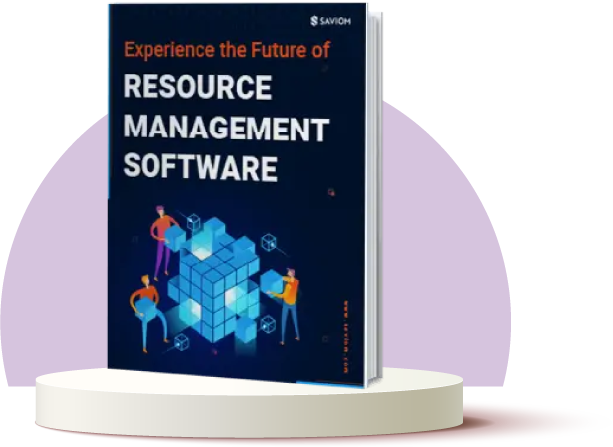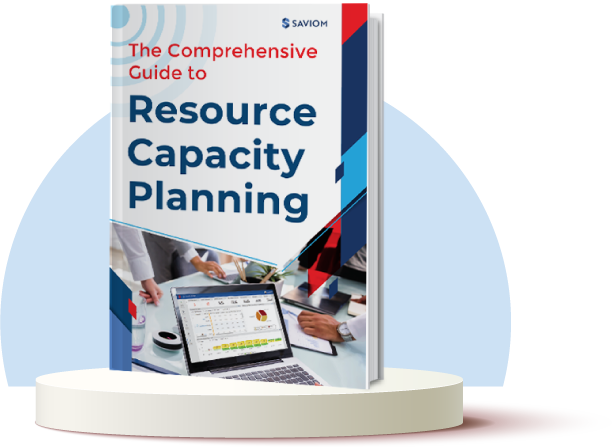Resources are the most valuable asset of any organization. So, managing them efficiently across all functional units is critical to ensure business profitability and long-term sustainability. However, as organizational structures become more convoluted and project complexities increase, companies often struggle to plan, develop, and optimize their enterprise resources.
Consequently, it leads to operational inefficiencies, higher resourcing costs, sub-par deliverable quality, and revenue loss. This is where a Resource Management Plan becomes indispensable. It serves as a roadmap that outlines how resources—people, tools, finances, and materials—are allocated, monitored, and optimized to achieve project and business objectives.
A well-defined resource management plan ensures that the right resources are available at the right time to maximize workforce efficiency, enhance productivity, and prevent unnecessary costs.
In this blog, we will discuss the nitty-gritty of a resource management plan, including its definition, types, key components, benefits, steps, and best practices.
What is a Resource Management Plan?
A resource management plan is a comprehensive document that outlines how organizational resources, such as personnel, equipment, finances, etc., will be allocated, managed, and utilized throughout the project lifecycle. Moreover, it ensures that organizations are always equipped with the right talent pool, reduces unnecessary resourcing costs, ensures seamless project execution, and maximizes ROI.
Let us now see the types of resource management plans.
Types of Resource Management Plans
Irrespective of the organizational structure, resource management plans vary based on specific needs.
Below mentioned are a few types:
Human Resource Management Plan
A human resource management plan outlines how an organization will manage its workforce across various functional units. It focuses on forecasting, planning, utilizing, and optimizing human resources to ensure workforce efficiency, productivity, and alignment with organizational goals.
Project Resource Management Plan
This outlines how project resources, including personnel, materials, and tools, are allocated, managed, and utilized throughout the project lifecycle. It helps project managers avoid resource shortages, control project budgets, and ensure successful delivery.
Read More: Mastering Project Resource Management: A Comprehensive Guide
Financial Resource Management Plan
A financial resource management plan outlines how organizations manage their financial resources to support business operations. It ensures that funds are allocated effectively, expenses are controlled, and financial risks are minimized. This helps firms maintain a healthy cash flow and boost profitability.
Digital Resource Management Plan
It outlines how an organization manages its digital assets, documentation, and IT infrastructure to ensure accessibility, security, and efficiency. This helps streamline the storage, organization, and usage of digital resources, preventing data loss, duplication, or mismanagement.
Equipment Management Plan
An equipment management plan outlines how an organization manages its physical assets, including facilities, tools, machinery, and other essential equipment. It ensures that these resources are procured, maintained, and utilized efficiently to support business operations and project execution.
Now that we understand what a resource management plan is and its various types, let’s explore its key components.
Read More: Project Management vs. Resource Management
What to Include in a Resource Management Plan?
Here are some key elements that should be included in a resource management plan:
Resource Requirements
A resource management plan outlines the type, quantity, and quality of resources required at the organization, department, and project levels. It includes human resources like skilled employees and specialized experts or non-human assets like equipment, technology, time, financials, etc.
Roles and Responsibilities
The comprehensive resource management plan details who the resources are, their specific roles, and the departments they belong to ensure clarity and accountability. It prevents role overlap, minimizes confusion, and ensures teams work cohesively while staying aligned with project objectives.
Resource/Project Organizational Chart
The plan includes a resource organizational chart that depicts the company-wide hierarchy of resources, reporting lines, and professional attributes. In contrast, a project organizational chart outlines a tiered reporting structure within a specific project. It includes sponsors at the top, followed by project managers, team leads, team members, etc.
Read More: What are Project Resources? How to Manage Them Effectively?
Resource Requisition Process
A resource request workflow is a crucial part of a resource management plan as it standardizes how resources are requested, approved, and allocated to projects. By including it, organizations ensure a structured approach to resource allocations, prevent last-minute scheduling chaos, and minimize delays or operational inefficiencies.
Contingency Plans
A contingency plan should be included in a resource management plan to prepare for unexpected disruptions like resource unavailability, budget overruns, or changes in client requirements. Outlining backup strategies or mitigation measures helps maintain project workflow and minimizes risks.
Training & Skill Development
A resource management plan includes training and skill development to enhance workforce capabilities, ensuring resources stay adaptable to evolving project needs. By upskilling employees, organizations can close skill gaps, improve productivity, and optimize resource utilization.
Read More: How Can Retraining/Upskilling Future-Proof Your Workforce?
Performance Metrics
A resource management plan also outlines key performance metrics managers must track to maintain organizational efficiency and productivity. These include resource utilization, cost per unit, turnaround time, etc. Monitoring these metrics helps reduce costs, optimize resource allocation, and boost profitability.
Now, let us move on to the importance of resource management plans.
Importance of Resource Management Plans
It is crucial for all firms to develop a resource plan to ensure efficient operations and optimal resource use. Below are a few benefits of devising a resource management plan.
Minimizes Resourcing Costs Across the Organization
A well-structured plan ensures that managers create a cost-effective mix of permanent/contingent resources and junior/senior talent while ensuring skills and competency. Furthermore, by incorporating a multi-location strategy across matrix boundaries, firms can source global/local talents, thereby maintaining the project’s financial efficiency.
Read More: 5 ways to Reduce Project Management Costs
Aligns Capacity with Current and Future Demand
A resource management plan helps managers forecast current and future demand proactively, allowing them to perform capacity vs. demand analysis. This helps in detecting potential shortages or excess resources in advance and gives them enough lead time to address the demand gaps effectively.
Ensure Competent Allocation of Enterprise Resources
A well-devised resource plan ensures that the right resource, i.e., human, financial, and materials, is allocated to the right project. The plan lists out resources along with their skills, capabilities, and availability to identify the best-fit resource rather than the first visible resource, thereby improving outcomes.
Read More: What is Resource Allocation, and Why is it Important?
Maximizes Profitable Utilization of Resources
A well-structured resource management plan ensures resources are profitably utilized. It allows firms to track utilization levels in real time and reallocate resources to ensure they spend a substantial amount of their time on revenue-generating tasks instead of non-billable work. This ultimately enhances productivity and profitability.
Facilitates Proactive Resource Risk Mitigation
A well-planned resource management plan includes a comprehensive contingency strategy. It involves identifying resource risks such as workforce shortages, skill obsolescence, unplanned attrition, etc., and developing targeted responses to mitigate them. This helps firms prevent project disruptions and ensure operational continuity.
Read More: Risk Matrix in Project Management: An Ultimate Guide
Future-proofs the Business Against Market Volatility
A strong resource management plan helps businesses stay resilient by forecasting skill demands and identifying existing competency gaps, if any. By recognizing these gaps early, firms can invest in training and upskilling initiatives to bridge them. This ensures that firms have a skilled & adaptable workforce that’s capable of seizing emerging opportunities and keeping the business competitive.
Let us now see the ways to build a resource management plan.
How to Build a Robust Resource Management Plan?
A robust resource management plan includes a few steps, and mentioned below are a few crucial ones:
Assess Resource Requirements Across Multiple Dimensions
The first step in a resource management plan is to gather resource requirements from all dimensions across the organization. To do this, managers must first assess the project pipeline by evaluating the project scope, objectives, timelines, etc. Based on this insight, they can determine the type, quality, quantity of resources needed, as well as the duration for which they will be required.
For example, a construction company planning a commercial project must assess resource needs across all phases, including engineers, laborers, site managers, machinery, raw materials, and safety equipment. By aligning these resources with project phases, the company ensures smooth execution within budget.
Create a Capacity Plan to Identify and Bridge Demand Gaps
The next step, capacity planning, involves assessing current resource capacity against forecasted demand to identify the resource shortages/excess. Based on this analysis, managers will take corrective resourcing measures to bridge that gap. For instance, in case of resource shortages, firms can address them through targeted training, upskilling, planned hiring, etc.
On the other hand, in case of resource excess, firms can bring forward project timelines or sell the additional capacity at discounted rates. This helps organizations prevent last-minute firefighting for competent resources, enhances cost efficiency, and improves project delivery.
Read More: What is Resource Capacity Planning? An Ultimate Guide for Every Project Manager
Build a Resource and Project Organizational Chart
A resource and project organizational chart will provide a standard visualization of the relationships between resources, project roles, and responsibilities. A resource organizational chart is a visual representation of the reporting structure within a department. On the other hand, a project organizational chart depicts the reporting lines, tasks assigned, and responsibilities within the project team.
To create a resource chart, firms must gain complete visibility into the talent pool to understand the departments, job roles, responsibilities, and skills of individual members and accordingly establish reporting lines and hierarchies. For project charts, managers must identify key individuals participating in the project. Then, they can create a hierarchy and outline their roles, like sponsor, project manager, team lead, and team members.
Develop an Enterprise Resource Schedule
An enterprise resource schedule provides a comprehensive view of resource allocations across the organization. It offers real-time insights into current and future employee schedules, individual work calendars (e.g., four-day or five-day schedules), or planned leaves, if any, in one place.
Further, this data can be typically viewed on daily, weekly, or monthly scales. Equipped with this information, managers can swiftly determine whether employees are available for new work, optimally engaged, or overloaded. Accordingly, firms can take suitable measures to enhance resource efficiency, maximize productivity, and maintain seamless operations.
Read More: How to Perfect Resource Scheduling Techniques within Project Planning?
Define the Resource Requisition Process
It is important for the project managers to raise detailed resource requests specifying the type of resources needed, required skill sets, cost considerations, location, duration, etc. This enables resource managers to identify and secure the right employees in time, ensuring a smooth project execution.
For example, if a project requires a data analyst with expertise in SQL and Python for a six-month engagement, the project manager submits a requisition outlining these requirements. The resource manager then evaluates the internal and external channels to fill the role for successful project outcomes.
Set Performance Metrics and Clarify Tracking Methods
Defining key performance metrics ensures that resources are planned, allocated, and utilized efficiently and that project goals are met within the planned timeline & budget. For that, managers should define KPIs such as resource utilization rates, billable versus non-billable hours, task completion efficiency, cost variance, etc.
By leveraging performance tracking tools like real-time dashboards, time-tracking software, etc., firms can monitor these metrics against a set baseline to quickly identify deviations such as budget overruns, resource over-utilization, and more. Accordingly, managers can take corrective actions to keep projects on track.
Read More: 7 Critical Project Metrics that You Should Track
Outline How Resources Will be Managed and Optimized
A resource management plan should outline how resources will be managed in case of bottlenecks like capacity gaps, budget overruns, or seasonal peaks and troughs. When these issues arise, managers can optimize resources at different levels, such as capability, cost, location, season, & utilization, to ensure successful project delivery.
For example, if a critical project requires niche expertise that is unavailable in-house, capability optimization can be applied by upskilling existing employees or hiring relevant resources. This way, firms can ensure successful project delivery and boost profitability.
Establish Contingency Plans for Various Resource Risks
In the next step, managers must identify key resource risks such as demand fluctuations, skill mismatches, unplanned attrition, etc. These risks should then be categorized in a risk matrix based on their likelihood and impact, enabling firms to prioritize their response strategies effectively.
For instance, managers can create contingency plans such as keeping a backup for critical roles, keeping a reserve of essential supplies, etc., to address each risk proactively. These measures enable firms to sustain operational efficiency and navigate uncertainties with minimal disruption.
Secure Stakeholder Buy-in
Gaining stakeholder buy-in is crucial for securing approvals, budget, and organizational support for the resource management plan. To achieve this, managers must clearly demonstrate how the plan enhances resource efficiency, minimizes risks, and improves project outcomes, aligning with business objectives.
To reinforce stakeholder confidence, managers should present data-backed insights that highlight the plan’s tangible benefits. Additionally, they must hold review meetings, proactively address concerns, and integrate stakeholder feedback to strengthen commitment and ensure their long-term support.
Read More: Who are Project Stakeholders? 7 Effective Ways to Manage Them
Periodically Review and Adapt the Plan
Once the resource management plan is in place, it must be periodically reviewed to ensure it remains effective amid evolving business needs, shifting priorities, and unforeseen challenges. To do so, firms should track key metrics such as resource utilization, billable vs. non-billable hours, and cost variances.
If inefficiencies are identified, managers can take proactive measures to optimize resource allocation, enhance productivity, and minimize unnecessary costs. Moreover, these regular reviews ensure that resources are aligned with strategic objectives, supporting long-term business success.
Now that we saw the ways to build a resource management plan, let us move on to the best practices to make it more effective.
Best Practices for Resource Management Plan
To make a resource management plan truly effective, it’s important to focus on practical strategies that enhance operational efficiency and achieve project success. Here are some key best practices to keep in mind:
- A resource management plan should be simple, easy to understand, and devoid of unnecessary complexity that could slow down decision-making. Also, making it accessible ensures that all managers can refer to it whenever needed, improving collaboration and execution.
- Adhering to the budget in a resource management plan is essential to allocate resources effectively, control expenses, and ensure profitability. Additionally, it supports future growth planning, ensures smooth operations, and keeps stakeholders satisfied.
- Reviewing past resource data helps refine future planning by identifying resourcing trends, utilization patterns, and potential inefficiencies. Learning from historical data enables managers to make informed decisions and avoid repeating past mistakes.
- Clear communication of the resource management plan to team members ensures alignment and accountability. When everyone understands their roles, duties, and priorities, execution becomes smoother, reducing misunderstandings and delays.
Read More: Types of Resource Management Models and How to Choose the Right One?
We now know a few best practices to improve the resource management plan. Let us now look at how resource management software can help in it.
The Role of Resource Management Software
Modern resource management software can help in devising a resource management plan with its ability to centralize data, automate scheduling, and provide real-time insights. Here are a few features that can help:
- The software provides multidimensional analysis, allowing managers to slice and dice the resource plans across different organizational dimensions like skills, team, location, role, or department.
- Next, the embedded capacity planner dynamically manages resource shortages and excess, helping organizations proactively address demand fluctuations without last-minute disruptions.
- The tool also has embedded heat mapping, which helps in revising resource plans by balancing workloads by identifying underutilized and overutilized resources.
- Additionally, intelligent matchmaking ensures that the right resources are allocated to the right tasks at the right cost, improving efficiency and cost-effectiveness.
- With KPI forecaster, managers gain foresight into potential resource challenges, enabling proactive planning and better control over key performance indicators.
- The tool’s real-time competency matrix records and updates skills, expertise, and certifications across the firm, helping managers make informed allocation decisions and optimize resource planning.
- The tool also provides real-time BI analytics and reports that enable businesses to track employee performance, utilization, and project progress instantly, facilitating informed decision-making.
- The tool allows managers to automate multiple workflows such as resource requisition workflow, skill-management workflow, etc. Moreover, it also offers
both automatic and manual integration with various disparate systems, allowing you to create a single source of truth. - Finally, the what-if analysis allows organizations to simulate different resource planning scenarios, helping them make informed decisions and mitigate potential risks in advance.
Final Thoughts
“The most important assets of a company are its people.”
– Jorge Paulo Lemann
A company’s success relies on managing all its resources efficiently, including people, equipment, budget, and time. For this purpose, companies need to implement a well-structured resource management plan. This will ensure optimal planning, scheduling, allocation, fewer resource risks, and better project outcomes. Thus, firms can boost productivity, cut costs, and stay adaptable.
So, is your firm still following the haphazard structure of managing resources, or is it time for a structured approach?
The Glossary
Read More: Glossary of Resource Workforce Planning, Scheduling and Management











